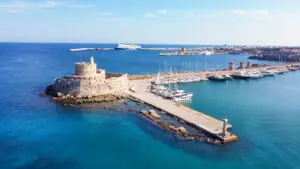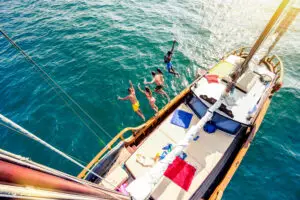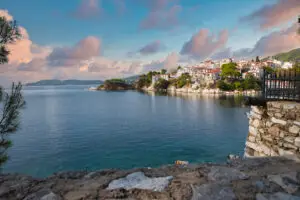
Rhodes, Greece – Sailing Through Myth, History & Hidden Harbors
Welcome to Rhodes Sailing to Rhodes The crown jewel of
Far away from the bustle of Greece’s famous tourist hotspots lies a rare gem that remains blissfully untouched by mass tourism — Antikythera. Nestled between Crete and the Peloponnese, this small island is a place where time slows down, the sea glistens with unspoiled clarity, and history whispers from every rocky cliff.
For travelers in search of authenticity, nature, and peace, this Antikythera Island Travel Guide is your complete resource. From its unique archaeological heritage to its serene beaches, from local festivals to hiking trails scented with wild thyme, Antikythera offers a kind of Greek island experience that feels almost lost in time.
Whether you’re coming for the legendary Antikythera Mechanism, the migrating Eleonora’s falcons, or simply to sit by the harbor with a coffee as fishing boats glide by, you’ll find that this island rewards those who take the slower road. Let’s dive into the essentials — and a few secrets — that will make your trip unforgettable.
Tucked between Kythira to the north and Crete to the south, Antikythera Greece sits almost exactly where the Aegean meets the Ionian Sea. Its location has made it an important navigational point for centuries, but it has never become a major tourist destination. That’s part of its magic.
The island is small — just under 21 square kilometers — and home to fewer than 50 permanent residents. There are no high-rise hotels, no cruise ship crowds, and no neon-lit party strips. Instead, there are rugged cliffs that plunge into sapphire waters, a single main village where life moves gently to the rhythm of fishing boats, and trails that lead you to quiet coves where you might not see another soul all day.
The isolation also means that the island retains a deep authenticity. Here, greetings are warm, neighbors know each other’s stories, and visitors are often treated as friends rather than tourists. You’ll leave not just with photographs but with connections.
Though it may seem sleepy today, the Antikythera Greek Island has been a witness to centuries of human drama. In ancient times, it was known as Aegila, a strategic outpost for traders, sailors, and at times, pirates. The island’s position made it both a gateway and a watchpoint, and over the years, it saw influences from Hellenistic, Roman, Byzantine, and Venetian rule.
The most famous chapter in its history began in 1900, when sponge divers discovered a shipwreck just off the coast. Among the treasures was the now-famous Antikythera Mechanism — a complex ancient Greek device often referred to as the world’s first analog computer. It could predict astronomical positions and eclipses decades in advance. Its discovery not only put the island on the archaeological map but also rewrote what historians thought they knew about ancient technology.
Beyond the Mechanism, the island hides ruins of ancient settlements, old churches with faded frescoes, and pathways that have been trodden for centuries. Walking here feels like moving through layers of history.
Part of what keeps Antikythera so special is that it’s not easy to get to. The island has no airport; the only way in is by ferry. Boats connect Antikythera with Kissamos in Crete, Neapolis in the Peloponnese, and the neighboring island of Kythira. Ferry services vary with the season, and in winter, crossings can be irregular due to weather — so it’s wise to check schedules well in advance.
The trip itself is part of the charm. As your ferry approaches, the island rises from the sea, its rugged coastline and sparse white houses framed by a backdrop of rocky hills. The main port of Potamos welcomes you with a small harbor, a few fishing boats, and perhaps a local fisherman mending his nets in the sun. From there, you can explore the island on foot or by arranging local transport.
For sailors exploring the southern Aegean, Antikythera is both a strategic stop and a serene haven. The island’s main harbor at Potamos offers basic mooring facilities, suitable for small to medium-sized yachts, with good shelter from the prevailing meltemi winds in summer.
Water and fuel availability is limited, so it’s best to provision in advance. Beyond Potamos, there are a few small anchorages such as Xiropotamos Bay, ideal in calm weather for a swim stop or an overnight anchorage.
Antikythera lies naturally along sailing routes between the Peloponnese, Kythira, and the western coast of Crete, making it an excellent waypoint for itineraries crossing from the Ionian to the Aegean. While amenities are minimal, the reward for dropping anchor here is a rare mix of calm waters, starlit nights, and the sense of mooring in a place where maritime history stretches back thousands of years.
1. Peloponnese – Antikythera – Crete Route (5–7 Days)
Begin your voyage from Neapolis in the southeastern Peloponnese and set a southerly course to Antikythera. The crossing is around 40 nautical miles and offers open-water sailing with the possibility of dolphin sightings. Spend a night moored at Potamos Harbor, exploring the village and enjoying a fresh seafood dinner. Continue south to Kissamos on the western coast of Crete, adding optional stops in Gramvousa and Balos Lagoon for postcard-perfect anchorages.
2. Kythira – Antikythera – Western Crete Route (4–6 Days)
Depart from Kythira’s Diakofti or Kapsali harbor and make the short 20–25 nautical mile hop to Antikythera. After a peaceful night in Potamos, sail onwards to the wild beauty of western Crete. This route is ideal for combining remote island charm with more developed harbors, allowing you to balance quiet anchorages with ports that offer better provisioning.
3. Ionian to Aegean Crossing via Antikythera (10–12 Days)
For adventurous sailors transitioning from the Ionian to the Aegean, Antikythera makes a perfect mid-point. Starting in Zakynthos or Kefalonia, hop south along the Ionian chain to Kythira, then across to Antikythera. From here, choose to continue east towards Crete or north-east into the Cyclades. This itinerary blends island-hopping with open-water passages, rewarding you with diverse landscapes, cultures, and sailing conditions.
| Route | Approx. Distance (NM) | Prevailing Summer Winds | Recommended Anchorage(s) | Notes & Tips |
|---|---|---|---|---|
| Neapolis (Peloponnese) → Antikythera → Kissamos (Crete) | Neapolis → Antikythera: ~40 NMAntikythera → Kissamos: ~38 NM | Meltemi N–NW, moderate to strong; calmer mornings | Potamos Harbor (good shelter)Optional: Xiropotamos Bay (calm weather) | Provision in Neapolis or Kissamos; limited supplies on Antikythera |
| Kythira → Antikythera → Western Crete | Kythira → Antikythera: ~22 NMAntikythera → Kissamos: ~38 NM | N–NW Meltemi; local gusts near headlands | Potamos Harbor; Balos Lagoon (Crete) | Ideal for 4–6 day trips; monitor forecasts for crossing |
| Zakynthos/Kefalonia → Kythira → Antikythera → Crete/Cyclades | Zakynthos → Kythira: ~120–140 NM total (with stops)Kythira → Antikythera: ~22 NM | NW–W in Ionian; shifting to N–NW in Aegean | Potamos Harbor; intermediate Ionian anchorages | Great Ionian–Aegean link; plan crossings for favorable weather windows |
Accommodation options here are intimate and personal. The selection of Antikythera Hotels consists mostly of small, family-run establishments located around Potamos. Rooms are modest but comfortable, with many offering balconies that open to views of the shimmering Aegean.
What these hotels lack in luxury amenities, they make up for in hospitality. The owners are often locals who know the island inside-out and are happy to share stories, recommend secret swimming spots, or even prepare you a home-cooked meal. Waking up here, you’ll hear seabirds, the sound of gentle waves, and perhaps the distant hum of a boat engine — a far cry from the noise of city life.
Because options are limited, it’s recommended to book well ahead during the summer months, particularly if you’re visiting during the mid-August religious festival.
For a more immersive experience, you might choose Antikythera Accommodation in the form of traditional houses or guest apartments. Many of these homes have stood for generations, built with thick stone walls to keep cool in summer and warm in winter, and furnished simply but with charm.
Staying in such accommodation lets you slip into the island’s daily rhythm. You might buy your breakfast bread from the small village store, greet fishermen returning with their catch, or sit outside in the evening sipping wine as neighbors stop by to chat. Some rentals are steps away from the water, so a pre-breakfast swim could become your favorite ritual.
This type of stay is perfect for travelers who want to experience Antikythera not just as a destination but as a temporary home.
The list of things to do in Antikythera isn’t about ticking off a long checklist; it’s about savoring each experience.
Swim in Secluded Beaches: Kamarela, with its dramatic rock formations and turquoise waters, is a must-see. Xiropotamos offers a longer stretch of pebbles and calm waves, perfect for a lazy beach day.
Hike Through Wild Landscapes: Trails crisscross the island, leading to viewpoints, chapels, and archaeological sites.
Birdwatching: The island is an important stop for migratory birds, especially Eleonora’s falcons in late summer.
Explore Archaeology: Visit the ruins of ancient settlements or the church of Agios Myronas, linked to local legends.
Join Local Festivals: The Feast of Panagia in August is the highlight, with music, dancing, and feasts that bring the entire island together.
Here, activities blend seamlessly into the environment — nothing feels rushed, and every moment invites you to slow down and appreciate the simplicity.
Antikythera’s coastline is raw and dramatic. Cliffs drop into deep-blue waters, while hidden coves beckon swimmers and snorkelers. Kamarela Beach is the star, with a natural rock arch that frames the sea like a postcard. Xiropotamos, near the village, is easily accessible and perfect for families.
Inland, the terrain is rocky but rich with wild herbs like thyme, oregano, and sage. Spring and early summer bring bursts of wildflowers, and the air is fragrant. The island’s relative isolation means much of its ecosystem is intact, making it a joy for nature lovers.
Life in Antikythera revolves around the essentials: the sea, the land, and community. Fishing remains central, and you’ll often see nets drying in the sun or small boats returning with the day’s catch.
The local cuisine reflects this closeness to nature. Expect grilled fish, octopus, local cheese, olives, and bread baked in traditional wood ovens. Meals are often shared events, accompanied by laughter and the occasional guitar or lyra.
Visitors quickly learn that here, the pace of life is not dictated by the clock but by the sun and the needs of the moment.
Of all the treasures the island has given the world, none is as famous as the Antikythera Mechanism. Discovered in a shipwreck dating to around 70 BCE, this intricate bronze device astonished scientists when they realized its complexity. Using a system of gears, it could predict solar and lunar eclipses, track planetary movements, and even mark the timing of the ancient Olympic Games.
While the original mechanism is housed in Athens, knowing that such a wonder was hidden for centuries just off these shores adds an extra layer of fascination to your visit. Some divers still explore the wreck site, which continues to yield artifacts.
Plan Ferries Early: Schedules can be sparse, especially in winter.
Pack Essentials: Shops are few and small; bring what you can’t do without.
Cash Over Cards: Not all businesses accept credit cards.
Stay Flexible: The island runs on its own rhythm — ferries can be delayed, shops might open late.
Respect the Environment: The island’s untouched nature is its treasure; keep it that way.
Antikythera may be small, but for those who make the journey, it delivers a sailing experience that blends history, nature, and the calm satisfaction of discovering a true hidden gem. Whether you drop anchor for a single night or linger to explore its coves and trails, this island leaves a lasting impression of authenticity and peace. For skippers planning wider voyages in the region, you can find more Ionian Islands anchorages.

Welcome to Rhodes Sailing to Rhodes The crown jewel of

Ormos Skorponeri Anchorage Travel Guide – Safe Mooring in Evia,

Sailing Route from Skiathos to Evia – The Quiet Passage
Contact Us Now to Create Your Dream Sailing Itinerary [email protected]